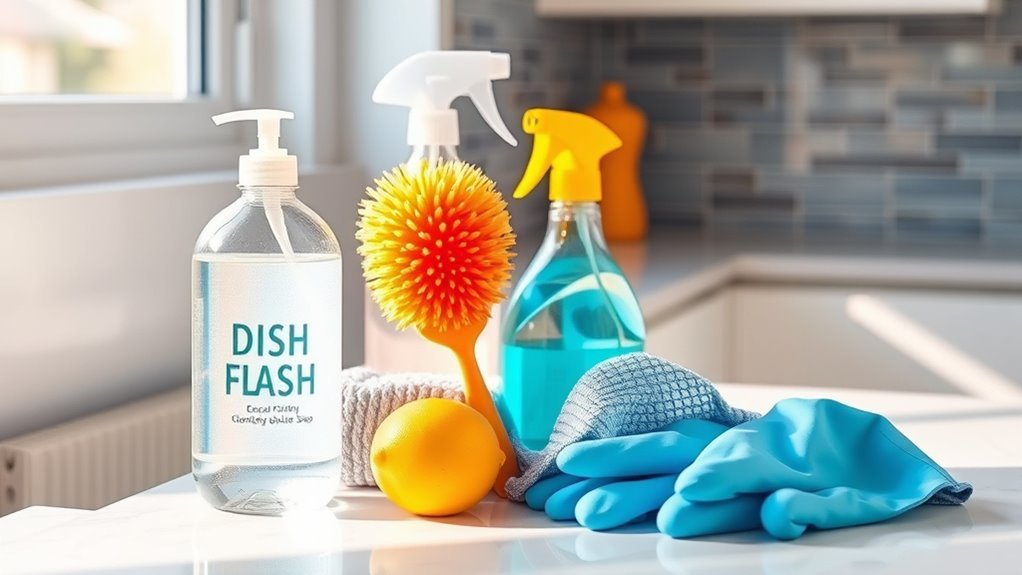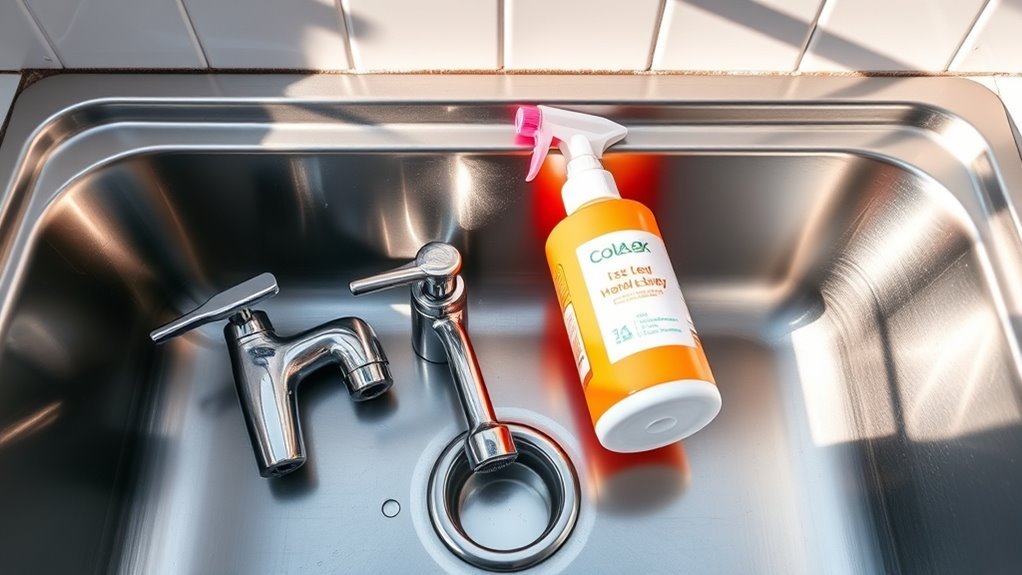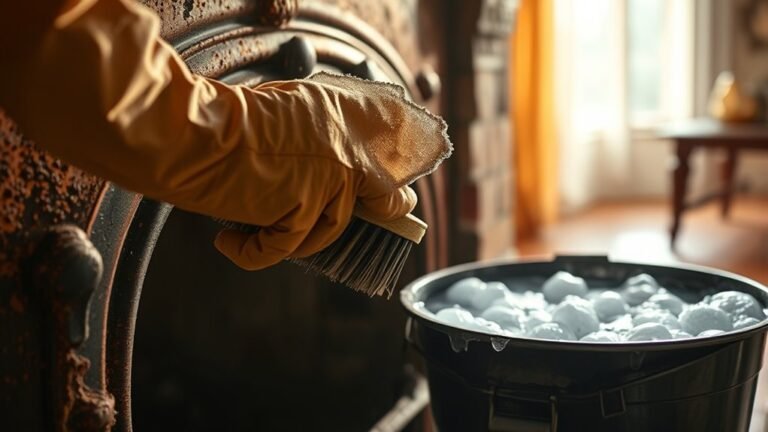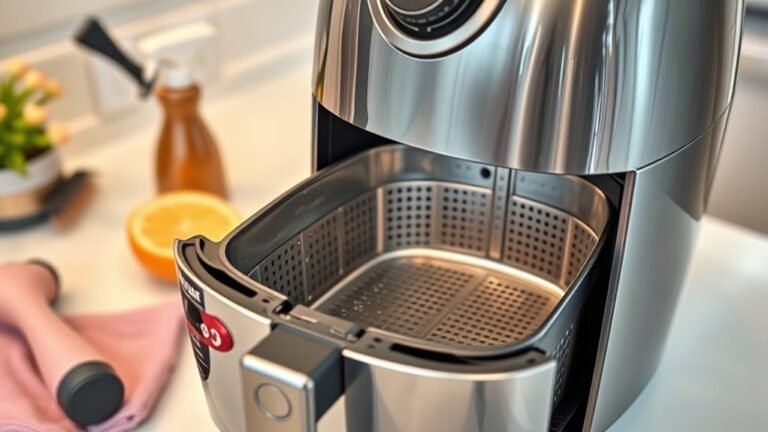Deep Cleaning Checklist for Sink
To deep clean your sink, first gather essential supplies like a soft sponge, microfiber cloths, baking soda, and vinegar. Clear the area, inspecting for grime or leaks. Remove accessories such as soap dishes and faucet aerators, soaking and scrubbing them thoroughly. Scrub the basin with a non-abrasive sponge and disinfect properly. Don’t forget to clear and maintain the drain and faucet to prevent clogs and leaks. Follow these steps carefully, and you’ll uncover even more tips to keep your sink spotless and efficient.
Gather Necessary Cleaning Supplies

Before you begin deep cleaning your sink, gather the essential supplies to streamline the process. Start with practical cleaning tools: a soft sponge, a scrub brush, microfiber cloths, and an old toothbrush for tight spots. Choose eco friendly products to maintain your freedom from harsh chemicals and protect the environment. Opt for natural cleaners like baking soda, white vinegar, and castile soap. These ingredients tackle grime without leaving toxic residues. Having a spray bottle filled with diluted vinegar simplifies application. Don’t forget gloves to protect your skin and a bowl for soaking removable parts. Organizing these supplies beforehand guarantees you work efficiently and thoroughly, making the deep cleaning task less intimidating. With the right tools and eco conscious products at hand, you’re set for a cleaner, healthier sink experience.
Clear and Inspect the Sink Area
Once you’ve gathered your supplies, clear the sink and surrounding area completely. This step is essential for effective deep cleaning and maintaining ideal sink organization. Removing all items lets you spot dirt, grime, or damage that often hides beneath clutter. Keep in mind, adjusting your cleaning frequency depends on how often you use your sink and the condition you find.
Clear your sink area completely to reveal hidden grime and maintain effective cleaning and organization.
- Remove everything including soap dishes, sponges, and any dishes.
- Inspect the sink basin, faucet, and drain for buildup, stains, or leaks.
- Check the countertop and under-sink area for moisture or mold.
Remove and Clean Sink Accessories

With the sink area cleared and inspected, the next step is to remove all accessories like soap dishes, strainers, and faucet aerators for thorough cleaning. Carefully detach each sink accessory, noting how they fit for easy reassembly. Soak metal strainers and faucet aerators in a mixture of warm water and vinegar to dissolve mineral buildup. Use a small brush to scrub hard-to-reach crevices, ensuring grime and debris are fully removed. For plastic soap dishes, wash them with dish soap and warm water, rinsing thoroughly. Dry all sink accessories completely to prevent water spots and bacteria growth. These cleaning methods not only restore shine but also maintain the functionality of each component. Taking these steps grants you freedom from stubborn residues and keeps your sink area hygienic and efficient.
Scrub and Disinfect the Sink Basin
Grab a non-abrasive sponge or cloth and apply a suitable cleaning agent to the sink basin. To master effective sink cleaning techniques, follow these steps:
- Scrub the entire basin thoroughly, focusing on corners and edges where grime builds up.
- Rinse the basin with warm water, removing all soap residues to prevent streaks.
- Apply disinfecting products evenly, letting them sit for the recommended time to kill bacteria.
Using this methodical approach, you guarantee the sink basin is not only visibly clean but also hygienically safe. Stick to non-abrasive tools to protect your sink’s surface and choose disinfecting products designed for kitchen or bathroom use, depending on your sink type. This routine keeps your space fresh and under your control, freeing you from worries about germs or buildup.
Clean and Maintain the Drain and Faucet

Although the drain and faucet often get overlooked, maintaining them is essential for preventing clogs and ensuring smooth water flow. For effective drain maintenance, remove debris regularly and use a natural cleaner monthly. Faucet care involves wiping the aerator and checking for leaks to prolong its lifespan.
| Task | Method |
|---|---|
| Drain Maintenance | Clear debris, flush with baking soda and vinegar |
| Remove Clogs | Use a plunger or drain snake |
| Faucet Care | Clean aerator, inspect seals |
Stay consistent with these steps to enjoy a free-flowing, efficient sink. Proper drain maintenance and faucet care help you avoid costly repairs and keep your sink in top shape.
Frequently Asked Questions
How Often Should I Deep Clean My Sink?
You should follow frequency guidelines to keep your sink spotless and hygienic. Ideally, deep clean your sink at least once a week as part of a cleaning schedule. This routine prevents buildup and bacteria growth, giving you more freedom from frequent scrubbing later. If you use your sink heavily, consider increasing the frequency to twice a week. Sticking to a methodical cleaning schedule guarantees your sink stays fresh and maintenance is effortless.
Can I Use Natural Cleaners for Deep Cleaning?
Did you know that 70% of people prefer natural cleaning products for their eco friendly options? You can definitely use natural cleaning solutions for deep cleaning. Ingredients like baking soda, vinegar, and lemon juice work wonders without harsh chemicals. They’re safe, effective, and better for the planet. Just mix, scrub, and rinse. This method lets you keep your sink spotless while embracing a healthier, more sustainable lifestyle.
What Are the Best Tools for Cleaning Hard-To-Reach Areas?
When tackling hard-to-reach areas, you’ll want cleaning brushes with angled or narrow bristles to get into tight spots. Extension tools like long-handled scrubbers or flexible wands let you reach far without straining. Combining these tools guarantees thorough cleaning without hassle, giving you freedom from awkward positions. Choose brushes that fit the task—soft for delicate surfaces, stiff for grime—to work smart and keep every corner spotless effortlessly.
How Do I Prevent Mold and Mildew in the Sink?
Ever wonder why some sinks stay fresh while others get grimy and moldy? For effective mold prevention and mildew resistance, keep your sink dry by wiping it down after each use. Guarantee proper ventilation to reduce humidity, and regularly scrub with a vinegar and baking soda mix to eliminate spores. Don’t forget to check and clean the drain area, where moisture often lingers. This methodical routine helps you enjoy a cleaner, healthier sink freely.
Is It Safe to Use Bleach on All Sink Materials?
You shouldn’t use bleach on all sink materials because it can damage surfaces like natural stone, wood, or some metals. Instead, try bleach alternatives such as vinegar, baking soda, or hydrogen peroxide, which are gentler but still effective. Always check your sink’s material before cleaning and test any cleaner on a small area first. This way, you’ll keep your sink safe and clean without risking permanent damage.






